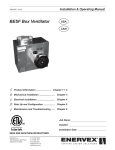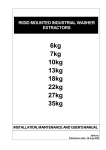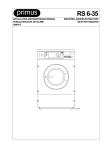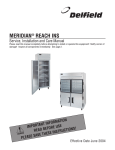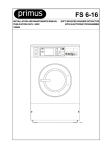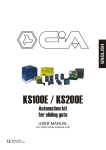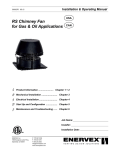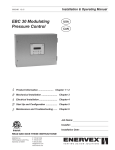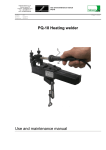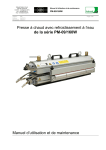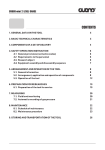Download Maytag FLOOR-2-FLOOR Technical information
Transcript
1. TABLE OF CONTENTS 1. TABLE OF CONTENTS.................................................................................................... 2 2. IMPORTANT SAFETY INSTRUCTIONS......................................................................... 2 3. TECHNICAL INFORMATION ........................................................................................... 4 3.1. SPECIFICATIONS 18/25/30/40 LB CAPACITY....................................................................................4 3.2. SPECIFICATIONS 50/60/80 LB CAPACITY.........................................................................................5 4. DIMENSIONS AND COMPONETS OF THE MACHINE .................................................. 6 5. HANDLING, TRANSPORT, STORAGE, UNPACKING ................................................... 8 6. FOUNDATION................................................................................................................... 8 6.1. GENERAL .........................................................................................................................................8 6.2. PREPARING FOUNDATION BASE...................................................................................................9 6.3. DIMENSIONS FOR FOUNDATION BASE.........................................................................................9 6.4. DIMENSIONS AND POSITIONING OF THE ACHORING ...............................................................10 6.5. DIMENSIONS AND POSITIONING RISERS ...................................................................................11 7. HOW TO INSTALL A WASHER..................................................................................... 12 7.1. MFR WASHER OR RISER INSTALLATION ON A CONCRETE PAD. ............................................12 7.2. MFR WASHER INSTALLATION ON A STEEL BASE (RISER) .......................................................12 7.3. SECURELY FASTEN THE WASHER..............................................................................................12 8. ELECTRICAL .................................................................................................................. 13 8.1. ELECTRICAL REQUIREMENTS .....................................................................................................13 8.2. ELECTRICAL CONNECTION..........................................................................................................13 8.3. LOAD ON ELECTRICAL SUPPLY NETWORK ...............................................................................14 9. WATER CONNECTION .................................................................................................. 15 10. WATER DRAIN CONNECTION.................................................................................... 15 11. AIRVENT OPENING ..................................................................................................... 16 12. LIQUID SOAPS CONNECTION ................................................................................... 16 13. MAINTENANCE AND ADJUSTMENTS ....................................................................... 17 13.1. DAILY ............................................................................................................................................17 13.2. EVERY SIX MONTHS ...................................................................................................................17 13.3. ADJUSTMENT OF DOOR SEAL PRESSURE ..............................................................................17 13.4. ADJUSTMENT GEAR BELTS .......................................................................................................18 13.5. REPLACEMENT WASHER FUSES ..............................................................................................18 13.6. ERROR INDICATION SHOWN ON DISPLAY ...............................................................................19 14. PUTTING THE MACHINE OUT OF SERVICE ............................................................. 19 14.1. DISASSEMBLY .............................................................................................................................19 15. LIST OF RECOMMENDED SPARE PARTS ................................................................ 20 516828 PUBLICATION DATE Nov 05 INSTALLATION INSTRUCTIONS 1 1. TABLE OF CONTENTS 2. IMPORTANT SAFETY INSTRUCTIONS WARNING - Read the IMPORTANT SAFETY INSTRUCTIONS in this manual carefully before operating the washer. Improper use of the washer may cause risk of fire, electrical shock or serious body injuries or death as well as serious damage to the washer. WARNING - Failure to comply with the instructions in this manual may lead to incorrect use of the washer, and may result in risk of fire, bodily injuries or death and/or damage to the laundry and/or the washer. Save these instructions for later use ♦ This English version is the original version of this manual. The instructions for the washer extractor are only complete with the programming and user manual. ♦ The washer extractor is designed for fabrics washing only, other objects can damage the machine and can cause damage or injuries. ♦ The manufacturer is not responsible for the damage to the fabrics that are washed by an inappropriate washing method. ♦ Always follow the instructions and/or warnings that are stated on the fabrics, washing products or cleaning products mentioned by the manufacturer. ♦ The washer must be set up in accordance with the instructions. All drain, inlet, electrical connections, ventilation, groundings and other connections must be done in according to the installation manual, in compliance with the local standards done by qualified technicians with proper authorization. The valid standards for connecting to the local power network must be followed. In the standard execution, the washer may not be suitable for connecting to an IT supply system. Contact your commercial distributor for assistance. ♦ Never install this washer on any level (or floor) but the ground level. There should never be a floor (such as a basement) located directly under the washer. ♦ The washer should always be tested before use. ♦ If the machine is used for special applications follow the instructions and warning to avoid person injury. ♦ Keep the washer surface and the area around clean and clear of combustible or flammable products. ♦ Do not wash articles that have been previously cleaned in, wash in soaked in, or spotted with gasoline, dry-cleaning solvents, or other flammable or explosive substances as they give off vapors that could ignite or explode. ♦ Do not add gasoline, dry-cleaning solvents, or other flammable or explosive substances to the wash water. These substances give off vapors that could ignite or explode. ♦ Under certain conditions, hydrogen gas may be created in the hot water system that has not been used for two or more weeks. HYDROGEN GAS IS EXPLOSIVE. If the hot water system has not been used for such period open all hot water taps and let the water run out for few minutes. This will release any accumulated gas. As this gas is flammable, do not smoke or use open flames during this time. ♦ Always strictly comply with the instructions that are written on the laundry chemicals-, laundry aids-, dry-cleaning solvents- and disinfectants packaging. Keep these agents out of the reach of children, preferably in a locked cabinet. ♦ Do not tamper the washer-extractor controls and do not bypass the safety instructions and the warnings. ♦ Do not remove warning signs placed on the machine. Observe signs and labels to avoid personal injuries. ♦ Do not put some part on the soap dispenser lid to hold it open by filling or when the machine operates. ♦ Do not open the soap dispenser lid after the machine is started. The discharge or splashing of hazardous liquid can cause serious scalding and burning. ♦ Do not operate the washer when parts are broken or missing or when covers are open. The machine shall not be operated until the fixed guards are put correctly in place. ♦ The washer is not designed for work which may create an explosive atmosphere inside the machine and will not be used for this purpose. ♦ The washer must not be stored or exposed to the weather, extreme low or high temperature and humidity levels. Do not hose down the washer. NEVER allow the washer to get wet. ♦ Check the functioning of the door lock mechanism on regular base. NEVER bypass the doorlock mechanism. ♦ Disconnect the power and water supply before cleaning, servicing or if the washer is not used for certain period. ♦ Out of the venting at the back of the washer can escape warm vapor or and hot air. Do not cover the vent but protect it sufficiently. It serves air gap and as a vapor outlet to prevent pressure building in the washer. 2 INSTALLATION INSTRUCTIONS PUBLICATION DATE Nov 05 516828 ♦ Do not repair or replace any part of the washer or attempt any servicing unless specifically recommended in the service manual or published user-repair instructions that you understand and have the skills to carry out. Only qualified service personnel may open the washer to carry out servicing. ♦ Information contained in this manual is intended for use by a qualified service technician familiar with proper and safe procedures to be followed when repairing an electrical appliance. All tests and repairs should be performed by a qualified service technician equipped with proper tools and measuring devices. All component replacements should be made by a qualified service technician using only factory approved replacement parts. ♦ Improper assembly or adjustment may occur if service or repair is attempted by persons other then qualified service technicians or if parts other then approved replacement parts are used. Improper assembly or adjustment can create hazardous conditions. ♦ There can be a risk of injury or electrical shock while performing services or repairs. Injury or electrical shock can be serious or even fatal. Consequently, extreme caution should be taken while performing voltage checks on individual components or a product. PLEASE NOTE: Except as necessary to perform a particular in servicing a product, the electrical power supply should ALWAYS be disconnected when servicing a product. ♦ All industrial (OPL - On Premise Laundry) washers are designed for use in Laundry with professionally trained attendants. ♦ The manufacturer reserves the right to change the manuals without previous notice. ♦ Before the appliance is removed from service or discarded, remove the door. ♦ Follow all valid basic safety rules and laws. ♦ If a problem should arise, contact your dealer for assistance. ! WARNING -- CAUTION In order to minimize the risk of fire, electrical shock and injury, THIS WASHER MUST BE PROPERLY GROUNDED. Never plug in or direct-wire an appliance unless it is properly grounded in accordance with all local and national codes. If more machinery in the same location, mutual grounding must be applied where possible. ! WARNING -- CAUTION The washer is a rigid-mount model, it MUST be secured mounted to a NON-COMBUSTIBLE foundation or adequate floor structure. NEVER install the washer on an upper floor or over a basement without a load support designed by a structural engineer. It is required the installation be on a concrete foundation. Metal reinforced wood floors are NOT allowed due to the risk of fire and excessive vibrations. ! WARNING Although the washer may be in the “off” position, there is still electrical power to the switch supply terminals. ! WARNING When power supply has been switched off wait for at least 10 minutes before starting inspection or servicing the machine. Some parts carry’s for a longer time voltage. ! WARNING Never permit children to play in or around the washer at any time. Never permit children to operate the washer. Close supervision of children is necessary when the appliance is used near children. ! WARNING Do not open door until cylinder remains stopped and water has been drained completely. If the door safety lock does not work, do not use washer until the door lock mechanism is repaired. ! CAUTION! The instructions in this manual cannot account for every possible dangerous situation. It is up to the user to take proper care when operating the washer. ! CAUTION! Safety labels appear at crucial locations on the machine. Failure to maintain legible safety labels could result in injury to the operator or service technician. ! CAUTION! If the installed machines operate with coin, token or similar operation, then the owner-installer must provide a remote-located emergency stop device. This device must be placed in such a way that it is easy and safely accessible for the users. The emergency stop device takes care that at least the control circuit of the washer extractors is interrupted. ! CAUTION! Any Water Leaks Must Be Repaired Immediately 516828 PUBLICATION DATE Nov 05 INSTALLATION INSTRUCTIONS 3 3. TECHNICAL INFORMATION 3.1. Specifications 18/25/30/40 Lb Capacity Capacity: Packing: Width Depth Height Transportation Volume Machine: Width Depth Height Inner drum: Diameter Depth Drum Volume Door Opening Weight Net Gross Power Supply Supply deviations Nominal motor output Current (Steady speed) Supply Protection Device 7 kg / 18 lb 10 kg / 25lb 13 kg / 30 lb 18 kg / 40 lb carton box 700 mm / 27.6" 730 mm / 28.7" 1180 mm/ 46.5" 3 3 0.6m / 21.2 ft carton box 700 mm / 27.6“ 990 mm / 38.98“ 1305 mm / 51.38" 3 3 0.9m / 31.8 ft carton box 810 mm / 31.9” 970 mm / 38.19” 1395 mm / 54.92” 3 3 1.1m / 38.85 ft carton box 935 mm / 36.8'' 955 mm / 37.6'' 1530 mm / 60.24'' 3 3 1.37m / 48.4 ft 660 mm / 26“ 710 mm / 28" 1045 mm / 41.1" 660 mm / 26“ 865 mm / 34" 1140 mm / 44.9“ 750 mm / 29.5” 820 mm / 32.3” 1225 mm / 48.2” 855 mm / 33.7'' 895 mm / 35.2'' 1315 mm / 51.8'' 530 mm / 21“ 330 mm / 13“ 73 dm3 / 19.3 gal 290 mm / 11.4“ 530 mm / 21“ 420 mm / 16.5“ 95 dm3 / 25 gal 290 mm / 11.4“ 650 mm / 25.6” 395 mm / 15.6” 131 dm3 / 34.6gal 410 mm / 16.1'' 700 mm / 27.6” 470 mm / 18.5'' 181 dm3 / 47.8gal 410 mm / 16.1'' 160 kg / 353 lbs 205 kg / 452 lbs 170 kg / 375 lbs 235 kg / 518 lbs 1x120V 60Hz ±10%, with max 1% of the frequency 600 W 5A 600 W 9A 10A 10A 285 Kg / 627 lbs 247 kg / 545 lbs 300 Kg / 660 lbs 262 kg / 578 lbs 1x208 / 240V 60Hz 3x208 / 240V 60Hz ±10%, with max. 1% of the frequency 0.75 kW 4.5A 15A 1.5kW 5A 15A Motor Overload electronic protection by the frequency inverter Protection Cylinder RPM 45 rpm 44 rpm 48 rpm Wash 48 rpm 525 rpm 505 rpm Spin max. 580 rpm 580 rpm 100 100 G-Factor max. 100 100 Floor Data 3.1kN / 675 lbs Ref. Static Floor Load 1.7kN / 370 lbs 12.1kN / 474 lbs 2.6 kN / 577 lbs 8.9 kN / 1994 lbs Max. dynamic load 3.6 kN / 801lbs 4.5 kN / 1020 lbs 6.5 kN / 1450 lbs Freq. of dynamic load 8.75 Hz 8.42 Hz 9.67 Hz 9.67 Hz Water Usage * * * * Average water Usage 65 l / 17 gal 90 l / 24 gal 115 l / 30 gal 160 l / 43 gal Average Hot water 15 l / 4 gal 23 l / 6 gal 30 l / 8 gal 42 l / 11gal Water Inlets: Cold and hot water connection water pressure 0.1 - 0.8 MPa / 14.5 - 116 PSI water inlet 3/4“ Water temp. max. hot water max 90°C-194°F Water Drain System Gravity dimension 76 mm / 3“ capacity By free drain 145 l/min / 38.3 US gallons/min Steam heating: Optional steam connection 1/2“ steam pressure 0.3 - 0.7 MPa / 45-100 PSI Liquid soap signals 8 (see electrical scheme) Soap Dispenser 3 compartments : Pre-wash -- Wash -- Last Rinse Handling Conditions Ambient temperature Storage: -25°C to +55°C; Operating: 1°C to +35°C relative humidity 30% ÷ 95% without condensation height above sea level: to 1000 m Average noise level 66 dB (A) * Depends on program and hot water temperature 4 INSTALLATION INSTRUCTIONS PUBLICATION DATE Nov 05 516828 3.2. Specifications 50/60/80 Lb Capacity Capacity: Packing: Width Depth Height Transportation Volume Machine: Width Depth Height Inner drum: Diameter Depth Drum Volume Door Opening Weight Net Gross Power Supply 27 kg / 60lb 35 kg / 80 lb carton box 935 mm / 36.8" 1050 mm / 41.3" 1530 mm / 60.24" 3 3 1.5m / 52.97 ft 22 kg / 50 lb Crating 950 mm / 337.4” 1220 mm / 48.03” 1570 mm / 61.,81” 3 3 1,82m / 64.26 ft Crating 1150 mm / 45.3" 1200 mm / 47.2" 1630 mm / 64.2" 3 3 2,25m / 79.4 ft 855 mm / 33.66" 990 mm / 38.98 1315 mm / 51.77" 870 mm / 34.25” 1140 mm / 44.88” 1380 mm / 54.33” 1110 mm / 43.7" 1140 mm / 44.88" 1460 mm / 57.5" 700 mm / 27.6“ 565 mm / 22.4“ 217 dm3 / 57.3 gal 410 mm / 16.1“ 750 mm / 29.53” 610 mm / 24.01” 269 dm3 / 71 gal 504 mm / 19.84” 914 mm / 35.98” 505 mm / 19.88" 355 dm3 / 93.7 gal 504 mm / 19.84” 290 kg / 638 lbs 310 kg / 682 lbs Supply deviations Nominal motor output 1.5kW Current (Steady speed) 5.5A Supply Protection Device Motor Overload Protection Cylinder RPM Wash Spin max. G-Factor max. Floor Data Max. Static Load Floor Max. dynamic load Freq. of dynamic load Water Usage Average water Usage Average Hot water Water Inlets: water pressure water inlet Water temp. max. Water Drain System dimension capacity Steam heating: steam connection steam pressure Liquid soap signals Soap Dispenser Handling Conditions Ambient temperature relative humidity height above sea level: Average noise level 415 kg / 915 lbs 689 Kg / 1519.2 lbs 475 kg / 1047 lbs 811 Kg / 1788.3 lbs 1x208 / 240V 60Hz 3x208 / 240V 60Hz ±10%, with max. 1% of the frequency 2.2 kW 3 kW 15A 7A 9A 20A 20A electronic protection by the frequency inverter 44 rpm 480 rpm 90 42 rpm 490 rpm 100 38 rpm 510 rpm 133 3.2 kN / 698 lbs 9.6 kN / 2165 lbs 8 Hz * 191 l / 50.5 gal 49 l / 13 gal 4.5 kN / 985 lbs 7.2 kN / 1598 lbs 13.3 kN / 2996 lbs 21.6 kN / 4863 lbs 8.5 Hz 8.17 Hz * * 231 l / 61 gal 284 l / 75 gal 61 l / 16 gal 76 l / 20 gal Cold and hot water connection 0.1 - 0.8 MPa / 14.5 - 116 PSI 3/4“ hot water max 90°C-194°F Gravity 76 mm / 3“ By free drain 145 l/min / 38.3 US gallons/min Optional 1/2“ 0.3 - 0.7 MPa / 45-100 PSI 8 (see electrical scheme) 3 compartments : Pre-wash -- Wash -- Last Rinse Storage: -25°C to +55°C; Operating: 1°C to +35°C 30% ÷ 95% without condensation to 1000 m 66 dB (A) * Depends on program and hot water temperature 516828 PUBLICATION DATE Nov 05 INSTALLATION INSTRUCTIONS 5 4. DIMENSIONS AND COMPONETS OF THE MACHINE 1. Control panel 2. Door handle 3. Service panel 4. Air relieve 5. Liquid soap hose passing 6. Serial Plate 7. Steam connection 8. Drain connection 9. Earth connection 10. Hot water connection 11. Cold soft water connection 12. Payment device or emergency stop 13. Fuses 14. Location incoming supply connector 15. Coin vault (only coin models) 16. Passing electrical cable of machine 17. Passing electrical liquid soap signals 18. Soap Dispenser Fig.1. 6 INSTALLATION INSTRUCTIONS PUBLICATION DATE Nov 05 516828 7 kg 18 lbs 10 kg 25 lbs 13 kg 30 lbs 18 kg 40 lbs 22 kg 50 lbs 27 kg 60 lbs 35 kg 80 lbs U 660 mm 26“ 1045 mm 41.1 “ 420 mm 16.5 “ 710 mm 28 " 620 mm 24.4 “ 102 mm 4“ 86 mm 3.4 “ 147mm 5.8” 188mm 7.4” 75mm 3.0” 267mm 10.5” 60mm 2.4” 897 mm 35.3 “ 182mm 7.2” 854 mm 33.6 “ 45 mm 1.8 “ 397 mm 15.6 “ 92 mm 3.6 “ 660 mm 26“ 1140 mm 44.9 “ 460 mm 18.1 “ 865 mm 34.1 " 775 mm 30.5 “ 102 mm 4“ 86 mm 3.4 “ 147mm 5.8” 188mm 7.4” 75mm 3.0” 267mm 10.5” 60mm 2.4” 992 mm 39.1 “ 182mm 7.2” 949 mm 37.4 “ 60 mm 2.4 “ 250 mm 9.8 “ 92 mm 3.6 “ 750 mm 29.5” 1225 mm 48.23" 430 mm 16.9 ” 820 mm 32.28” 740 mm 29.13” 102 mm 4“ 86 mm 3.4 “ 147mm 5.8” 188mm 7.4” 75mm 3.0” 267mm 10.5” 60mm 2.4” 1069mm 42.1” 182mm 7.2” 1025mm 40.4” 53mm 2.1” 333mm 13.1” 86mm 3.4” 855 mm 33.7 “ 1315 mm 51.8 “ 528 mm 20.8 “ 895 mm 35.24 " 855 mm 33.7 “ 10 mm 5.5 “ 94 mm 3.7 “ 157 mm 6.2 “ 190 mm 7.5 “ 75 mm 2.95 “ 382,5 mm 15.1 “ 75 mm 2.95 “ 1138 mm 44.8 “ 207.5 mm 8.2 “ 1117 mm 43.5 “ 99 mm 3.9 “ 435 mm 17.1 “ 134 mm 5.3 “ 855 mm 33.7 “ 1315 mm 51.8 “ 528 mm 20.8 “ 990 mm 39" 950 mm 37.4 “ 140 mm 5.5 “ 94 mm 3.7 “ 157 mm 6.2 “ 190 mm 7.5 “ 75 mm 2.95 “ 382,5 mm 15.1 “ 75 mm 2.95 “ 1138 mm 44.8 “ 207.5 mm 8.2 “ 1117 mm 43.5 “ 99 mm 3.9 “ 435 mm 17.1 “ 134 mm 5.3 “ 870 mm 34.25 1380 mm 54.33 " 458 mm 18.03” 1140 mm 44.88 " 1040 mm 40.95 “ 160 mm 6.3” 85 mm 3.3 “ 147 mm 5.79” 190 mm 7.48” 90 mm 3.54” 303 mm 11.93” 100 mm 3.94” 1205 mm 47.44” 123 mm 4.84” 1135 mm 44.68” 134 mm 5.28” 360 mm 14.17” 88 mm 3.46” V 330 mm 13 “ 330 mm 13 “ 375mm 14.8” 427.5 mm 16.8 “ 427.5 mm 16.8 “ 435 mm 17.13” 109 mm 4.3 “ 415 mm 16.3 “ 109 mm 4.3 “ 415 mm 16.3 “ 175mm 6.9” 521.5mm 20,5” 205,5 mm 8.1 “ 521.5 mm 20.5 “ 205,5 mm 8.1 “ 521,5 mm 20.5 “ 198 mm 7.8” 637 mm 25.08” 1100 mm 43.3 “ 1460 mm 57.48 " 508 mm 20“ 1140 mm 44.88 " 1040 mm 40.95 “ 125 mm 4.9 “ 85 mm 3.3 “ 165 mm 6.5” 297 mm 11.7” 100 mm 3.94” 320 mm 12.6” 130 mm 5.12” 1330 mm 52.36” 232 mm 9.13” 1235 mm 48.62” 118 mm 4.6 “ 360 mm 14.17 “ 88 mm 3.46 “ 400 mm 15.75 “ / 300 mm 11.8” 238 mm 9.4 “ 680 mm 26.8 “ Machine capacity A B C D E F G H J K M N P Q R S T X Y Table matching with fig. 1. 516828 PUBLICATION DATE Nov 05 INSTALLATION INSTRUCTIONS 7 5. HANDLING, TRANSPORT, STORAGE, UNPACKING For safety reasons, be sure that the persons that transport, handles and store the machines are informed about the machines specifications and information’s. Read and respect also the “IMPORTANT SAFETY INSTRUCTIONS” The machines with capacity 6-22 kg / 15-50 lbs is delivered to the customer in a cardboard packing and crating packing. Under the outside packing is the machine additionally protected by polyethylene foil. Do not store or install the machine where it can be exposed to environmental conditions (rain, wind) or extreme humidity. The machines are fixed to the wooden palette by four bolts M12x60. Before moving the machine into its final location, follow the following precautions: – Check all passages and spaces where the machine has to be transported through, they must have sufficient dimensions to meet the height and width of the machine including the package. – Lift the machine up by lift truck or hand-operated pallet truck using a transport skid to which the machine has been attached. Just before you install the machine in its final position, remove the packing, release four bolts of the pallet and lift up the machine and remove the wooden pallet. It is possible to handle the machine by the fork lift or the manual truck if the forks supporting the sides of the frame. If not, it can damage the components located in its lower part. After unpacking, check if the machine has not been damaged and if all the accessories are included according to your order. Verify the information of your machine at the name plate located on the machine rear and note corresponding information in the information sheet at the back side of the manual. The accessories and the manual are placed inside the drum. When moving the un-packed machine: – Never push, pull or press the components protruding from the contour line of machine (front part, filling door, control elements, belt cover, water inlet and outlet pipes etc.). – Make sure that the filling door are secured to avoid its opening during the handling. 6. FOUNDATION 6.1. GENERAL For safety reasons, be sure that the persons that install are informed about the machines specifications and information’s. Read and respect also the “IMPORTANT SAFETY INSTRUCTIONS” The washer is a rigid-mount model, it MUST be securely fixed mounted to a foundation to work properly and in a safe way. Note: It is strongly recommended that the MFR80 and 60 machines be mounted onto a not elevated concrete base only. We also recommend it for the MFR40 and 60. CAUTION: - Putting machines on an elevation or riser creates a higher distance to reach the soap dispenser. - Never put a riser on raised foundation. - The washer needs to installed always level or very slightly tipped with front higher, for sure not opposite. Therefore the foundation surface has to be made with these conditions. NEVER install the washer on an upper floor or over a basement without a load support designed by a structural engineer. It is required the installation be on a concrete foundation. Metal-reinforced wood floors and all not concrete foundations are NOT allowed due to a potential for excessive vibrations and fire. Improper installation will void the warranty. Maytag is not responsible for damage or injury caused by improper installation. 8 INSTALLATION INSTRUCTIONS PUBLICATION DATE Nov 05 516828 6.2. PREPARING FOUNDATION BASE Check the thickness of the existing floor and verify the quality of the concrete. The foundation MUST be always been engineered to be able to comply with the static and dynamic floor data. If necessary contact your building engineer. Use 3000 lb / 1360 kg test concrete for the floor and foundation. For max. strength, allow concrete to cure for min. of 72 hours in dry weather. Layout and mark the area of the entire washer base take into account and respect the distances to sides, ceiling and rear, see table. Add also minimum 4” / 10 cm on all sides of the entire washer base for the foundation re-enforcement if it concerns a raised foundation, riser foundation or a floor re-enforcement. Break up the floor to a depth mention in the table accordance the machine model, including the min 4”/10 cm around all sides. If a higher capacity model stands on the right or left hands side, select the depth of the higher capacity model for the concerned model. Undercut the sides of the hole to create an invert “mushroom” effect. It is essential to have a real good connection between the new foundation and the existing floor, therefore it is necessary to place rebar that are well (chemical) anchored in the existing floor or other types of reinforcement rods throughout the floor. Wet the hole well and brush the bottom and all sides with cement grout before pouring in the new concrete. This is required for a solid foundation and joint. If a raised foundation is used for some models, never make it higher then 12” / 30.5 cm. The overall dimensions must also be equal with the total washer footprint plus the required 4” / 10 cm on all sides. 6.3. DIMENSIONS FOR FOUNDATION BASE Fig. 2 516828 PUBLICATION DATE Nov 05 INSTALLATION INSTRUCTIONS 9 Machine capacity 7 kg 18 lbs 10 kg 25 lbs E 530 mm 20.9 “ 65 mm 2.6 “ 100 mm 4“ 20 mm 0.79 “ 48 mm 1.9 “ F 275 mm 10.83 “ 530 mm 20.9 “ 65 mm 2.6 “ 100 mm 4“ 20 mm 0.79 “ 48 mm 1.9 “ 365 mm 14.37 “ 90 mm 3.5 “ 158 mm 6.2 “ 700 mm 27.56 “ 600 mm 23.62 “ 560 mm 22.1” 38 mm 1.5” 605 mm 23.82 “ 300 mm 11.81” 100 mm 4” 40 mm 1.5” 7 mm 0.276” 300 mm 11.81” M16 5/8” 0 mm 0“ 295 mm 11.6 “ 28 mm 1.10 “ 700 mm 27.56 “ 700 mm 27.56 “ 725 mm 28.54 “ 38 mm 1.5” 605 mm 23.82 “ 300 mm 11.81” 100 mm 4” 40 mm 1.5” 7 mm 0.276” 300 mm 11.81” M16 5/8” 0 mm 0“ A B C D G H I J K L M N O P Q min. R max. S min. T 13 kg 30 lbs 18 kg 40 lbs 22 kg 50 lbs 27 kg 60 lbs 35 kg 80 lbs 594 mm 23.39” 78 mm 3.07” 100 mm 4“ 20 mm 0.79 “ 43 mm 1.7 “ 400 mm 15.75” 700 mm 27.6 “ 77.5 mm 3.1 “ 100 mm 4“ 20 mm 0.79 “ 75 mm 2.95” 700 mm 27.6 “ 77.5 mm 3.1 “ 100 mm 4“ 20 mm 0.79 “ 75 mm 2.95” 636 mm 25.04” 117 mm 4.61” 100 mm 4“ 20 mm 0.79 “ 46 mm 1.81” 820 mm 32.6 “ 140 mm 5.51 “ 100 mm 4“ 20 mm 0.79 “ 71 mm 2.8” 360 mm 14.17 “ 500 mm 19.68 “ 675 mm 26.57” 295 mm 11.61 “ 232 mm 9.13” 34 mm 1.34” 700 mm 27.56 “ 700 mm 27.56 “ 690 mm 27.2” 25 mm 1.0” 744 mm 29.3” 300 mm 11.81” 120 mm 4.7” 40 mm 1.5” 7 mm 0.276” 240 mm 9.45” M16 5/8” 0 mm 0“ 295 mm 11.61” 35 mm 1.4” 700 mm 27.56 “ 700 mm 27.56 “ 725 mm 28.54 “ 35 mm 1.4” 804 mm 31.6” 300 mm 11.81” 150 mm 6” 40 mm 1.5” 7 mm 0.276” 160 mm 6.3” M16 5/8” 0 mm 0“ 251 mm 9.88” 35 mm 1.4” 700 mm 27.56 “ 700 mm 27.56 “ 821 mm 32.3” 35 mm 1.4” 804 mm 31.6” 300 mm 11.81” 150 mm 6” 40 mm 1.5” 7 mm 0.276” 160 mm 6.3” M16 5/8” 0 mm 0“ 230 mm 9.06” 45 mm 1.77” 700 mm 27.56 “ 1000 mm 39.37 “ 995 mm 39.17” 45 mm 1.77” 864 mm 34.02” 300 mm 11.81” 230 mm 9” 40 mm 1.5” 7 mm 0.276” 80 mm 3.15 M20 3/4” 0 mm 0“ 295 mm 11.61 “ 46 mm 1.81“ 700 mm 27.56 “ 1000 mm 39.37 “ 963 mm 37.91” 57 mm 2.24” 1095 mm 43.11“ 300 mm 11.81” 230 mm 9” 95 mm 3.75” 0 mm M20 3/4” 270 mm 10.63” Table matching with Fig. 2 - 3 - 4 - 5 6.4. DIMENSIONS AND POSITIONING OF THE ACHORING Lay out and mark the total washer footprint and the fixation points of the washers. Bond j-bolts with diameter “S” x (P+O) (see for dimensions table above) into the concrete or drill into the cured concrete and install chemical anchoring bolts with respect to the dimensions indicated in the table, according to the washer model. Expansion bolts can be used but are not preferred. Mounting bolts must be designed to withstand 2500lbs. Always use the indicated bolt diameter and quality. The indicated depth (O) of the anchoring bolt must be firmly anchored into the concrete, and a min. dimension “P” must be protruding for proper attachment of the machine. For max. strength, allow concrete to cure for min. of 72 hours in dry weather. After curing check for J-bolt alignment, or install chemical anchoring bolts, or expansion bolts. 1. Foundation bolt 2. Nut 3. Machine Frame 4. Machine grout or shim 5. Foundation base 10 6. Rebar 7. Floor 8. Washer 9. Fixation Bolt 10. Riser INSTALLATION INSTRUCTIONS PUBLICATION DATE Nov 05 516828 Fig.3 Fig.4 6.5. DIMENSIONS AND POSITIONING RISERS When a riser is used, use a U-profile, respecting always the max. height and min. thickness given for each model in the table. The width and the depth should be, as a minimum, the same as the washer footprint dimension. It is recommended to add 1/4” / 6 mm to all dimensions. For MFR40/50/60 when the highest riser is used, it is highly recommended to add a U-profile reinforcement between left and right U-profile at the distance of the mid hole fixation. The horizontal member of the U-profile needs to have a width equal with the touching frame profile, at least 10 mm / 0.4” over the fixing hole of the frame profile. Before fixing the riser, please Read again the “GENERAL” of this chapter. The fixation of the riser to the concrete floor needs to be the exact same way and condition of the washer as described above. This also means that the riser needs to be fixed to the floor with the same quantity of anchoring bolts as the washer is fixed to the riser and in the same locations. Additional anchoring bolts are allowed on places where it does not reduce the strength of the riser or concrete pad. CAUTION: Be aware that some floor data given in the table will change when the risers are being used. Contact your structural engineer for floor and foundation conditions and adapted floor data in accordance with the riser being used. Do not use risers higher then indicated in the table Fig.5 516828 PUBLICATION DATE Nov 05 INSTALLATION INSTRUCTIONS 11 7. HOW TO INSTALL A WASHER First check if the concrete pad and/or riser conforms to the requirements. 7.1. MFR WASHERS OR RISER INSTALLATION ON A CONCRETE PAD. The washer or riser is positioned on the pad over the bolts and spaced above the pad approximately 3/8 inch to ½ inch using wooden “door-stop” wedges. The machine always needs to be installed level or very slightly tipped, with front higher (not more then 1/8” - 3.5 mm front to back), and resting on the wedges. Completely fill the space between the machine base frame or Riser and the pad with machinery grout under all frame surfaces. Most machinery grout will begin to set in about 20 minutes to ½ hour. When the grout is hardened to the touch, remove the wedges and fill in the gaps with additional grout. Be sure to leave a gap under the middle frame member and an opening in the perimeter grout for water to drain out in case of a leak. At this point “snug “ the washer, lock-washer and nut on each of the anchoring bolts to make sure the washer or riser is level or very slightly tipped, with front higher, (do not over-tighten the nuts at this time). Allow at least two hours (over night is preferred) before final tightening of the hold down nuts. 7.2. MFR WASHER INSTALLATION ON A STEEL BASE (RISER) If the base profile is such that the bolt surfaces are tapered, we recommend the use of special tapered washers against the base to avoid bending stress on the hold-down bolts. The steel base should be supported by machinery grout between the base and the floor. (see installation procedure above). When the base is installed (level or very slightly tipped with front higher) and the grout is cured, the washer can then be positioned on the base and bolted in place. Use Bolt-Nut accordingly in the table given with quality 8.8 for the bolt and 8 for the nut minimum. You will find a number of metal shims provided in the installation accessories package found in the washer tub. With the washer sitting firmly (bolts not tightened) on the base there may still be some slight “rock” in the washer. Use the shims to eliminate any movement BEFORE the hold-down bolts are tightened. Simply pulling any rock out of a washer frame using the holddown bolts will stress the frame and could lead to premature bearing and or frame failures. 7.3. SECURELY FASTEN THE WASHER Securely fasten the washer (and Riser) to the mounting base or foundation with washers and double nuts to assure safety. RETIGHTEN these nuts AFTER THE WASHER HAS BEEN OPERATEING for a few days. Recheck at six month intervals. DO NOT FORGET to release the counter nut before checking otherwise it is not possible to verify the right tightness of the washer (and riser). DO NOT FORGET to Retighten the counter nut after the check. 12 INSTALLATION INSTRUCTIONS PUBLICATION DATE Nov 05 516828 8. ELECTRICAL 8.1. ELECTRICAL REQUIREMENTS ! WARNING! • The washer extractor is intended to be permanently connected to the electrical supply. • This appliance must be connected to a supply, which no lighting units or general purpose receptacles are connected” • To prevent unnecessary risk of fire, electrical shock or personal injury, all grounding must be done in accordance with National and local codes, with the National Electrical Code, ANSI/NFPA (for the United States) or the Canadian Electrical Code CSA C22.1 (for Canada). • It is the responsibility of the installer to assure the washer is adequately grounded at the point of installation taking into considerations the National and local conditions and requirements. • An equipment-grounding conductor must be run with the circuit conductor and connected to the equipment-grounding terminal on the washer and where possible to a grounded metal, permanent system, for example a riser. • If other washers or appliance are in the vicinity, they need to be connected permanently with an equipment-grounding conductor. Grounding In event of malfunction or breakdown or leakage current, the ground will reduce the risk of electrical shock and serve as a protecting device, by providing a path of least resistance of electrical current. The gauge or section of the grounding wire needs to be at least the same as the supply wires. The supply conductor cable, for the washer, to a grounded power supply network (approved electrical service) must have copper conductors and with an in line on-off switch. The wire gauge or wire section depends on the machines total amperage requirement, data on the nameplate “Max. Supply Protecting Device” of the washer (see also “Technical information“). The protecting device and wire gauge needs to be installed according to table. Take care that the protecting devices can be safely accessed by service-maintenance people and protected from unauthorized personnel. Wire Section (mm2) Protecting Device Wire Gauge 10 A 12 AWG 2.5 15 A 12 AWG 2.5 20 A 12 AWG 4 Wire Section Note: The wiring diagram for each washer is located inside the cabinet on the left or right panel. 8.2. ELECTRICAL CONNECTION BEFORE OPERATION or TESTING, follow all grounding instructions in the Electrical Requirements Section. An individual branch circuit needs to be used for each appliance. DO NOT USE AN EXTENSION CORD. Insert the cable through the hole in the on the rear panel, insure a strain relief is used. Connect the power cable to the correct terminal post starting with L1 then L2 and if present L3 and Neutral. The grounding conductor (green-yellow) should be longer then the phase lines, in the event that a cable pulls out incidentally, the grounding conductor must be last to be disconnected. When using stranded copper conductors, use “wire end tubes” with an insulated sleeve to avoid accidental contact. 516828 PUBLICATION DATE Nov 05 INSTALLATION INSTRUCTIONS 13 Fig.6 Sag in front of cable passing and incoming supply terminal Provide a sag in the cable, in front of the cable strain relief. This will avoid ingress of condensed water into the machine, see picture. 8.3. LOAD ON ELECTRICAL SUPPLY NETWORK When multiple machines are connected to the same electrical network, it is necessary to connect the machines according to Fig. below. The 2 wires of the machine that feeds the frequency control of the machines has to be connected alternatively for the phase wire L1 and L2 of the network, the second machine with the L2 and L3 of the network, the third machine with the L3 and L1 of the network. The fourth machine must again be connected to the first phase L1 and L2 etc... This assures a better load division of the electrical network. Fig 7 14 INSTALLATION INSTRUCTIONS PUBLICATION DATE Nov 05 516828 9. WATER CONNECTION The washer is equipped with 3/4“ BSP (British Standard Pipe Thread) hot and cold water inlet valves, indicated by a sticker next to the inlet. Use the water inlet hoses that accompany the washer as they are properly adapted to the water valves. Water inlet hoses are BSP on one end and NPT (Nut marked with groove) on the other end. For best operation of the washer, water pressure must between 30 - 120PSI (pound per square inch) or 2 - 8 MPa. Water pressure that is below minimum requirements can lengthen the wash cycle or/and not allow proper function of the washer. To Install Flush the water system in order to remove any particles that may be in the water system. Insert the screen hose washer into the faucet connection end of the inlet hose and the standard hose washer at the opposite end of the inlet hose. When connecting inlet hoses, be sure hose connections are not cross-threaded on the water valves. Tighten securely by hand plus 1/4 turn with pliers. DO NOT over tighten as this will strip threads on the water valve(s). The water hardness can have an influence on the wash results. The soap supplier can help you with making the right decisions concerning hard water, soft water, washing programs, type of soap and other related items to give the best wash results. HOT WATER: The hot water supply needs to be large enough to provide the required hot water for the installed washers. For good wash results we advise a hot water supply that is set between 140 - 160°F / 60 - 70°C. To determinate the boiler capacity you can use the data in below table. Please be aware that this is an average and depends highly of the boiler temperature, linen, program set up and washing program used. MODEL 7 kg / 18 lbs 10 kg / 25 lbs 13 kg / 30 lbs 18 kg / 40 lbs 22 kg / 50 lbs 27 kg / 60 lbs 35 kg / 80 lbs Hot water dm3 gal 15 4 16 4.5 25 6.5 31 8 47 12.5 55 14.5 67 18 Average hot water use 10. WATER DRAIN CONNECTION The washer is equipped with a 75 mm / 3” O.D. drain valve which should be connected to the main drain pipe or drain sump. The main drain pipe must have adequate capacity to handle the total output of all connected washers and provide the necessary air release so that no back-pressure or/and drain slow down can be generated. Use the drain hose with elbow and clamp that accompany the washer as they are properly sized to connect to the washer drain outlet. Secure the drain hose with the clamp. The drain pipe or drain sump must be located lower than the machine drain pipes because the water discharges from the machines by gravity. Do not reduce the diameter of the machine drain pipes. Every time a machine is connected to the main drain pipe, the diameter of the pipe or the width of the waste channel must be sized properly. It is necessary to verify the main drain pipe or drain sump for proper function. If all washers are properly connected to the drain, let all washers drain the rinse water simultaneously. All washers should drain empty of water in approximately 30 sec or less. 516828 PUBLICATION DATE Nov 05 INSTALLATION INSTRUCTIONS 15 11. AIRVENT OPENING On the backside, the washers are provided with an air vent opening of O.D. 75 mm / 3". WARNING! Watch out, vapors escape from the machine through the air vent opening! Do not cover or connect to anything! Do not cover the washer air vent opening. It is part of the back flow prevention water system. It also takes care that the tub can not be pressurized by water intake and vapor of the hot water, this allows for proper measuring of the water level. For the safety of everyone make sure that unauthorized persons cannot reach the backside of the machine. 12. LIQUID SOAPS CONNECTION The washer has provision for connecting external dosing of liquid soaps. For connecting the liquid soap inlets and wiring the top panel needs to be opened. The hoses for liquid soaps are pushed through the holes in the rear panel after removing the plugs. The hoses should be protected by rubber rings where they are going through the rear panel. The connection of the liquid soap hoses are made at the rear side of the soap dispenser. By default, these nipples (max.5) are closed, so it is necessary to drill them out with drill bit 0.2” / 5 mm. Dill only the ones that will be used for connection to liquid soap hoses. Secure liquid hoses by means of clamps. WARNING! Check if the hoses are tightened by the clamps! Any leakage of chemicals may cause injury or corrosion on some of the parts in the machine. The wiring diagram, is located inside the cabinet on the left or right panel in the plastic bag. On the electronic control, is a sticker that indicate the availability of 8 liquid soap signals and their position. Fix the input wires in the matching 9-pole connector in according to the wiring diagram indicated and push him in the “Z” connector on the electronic controller. The code number for the matching 9-pole connector can be found in chapter “List of Recommended Parts” at the end of this manual. Caution: The first pin is common for the liquid soap signals and of the electronic controller. The signals are 12V dc and the current must be limited to 10 mA per signal Never put outside voltage to the pins of the “Z” connector. It will destroy the electronic controller. 16 INSTALLATION INSTRUCTIONS PUBLICATION DATE Nov 05 516828 13. MAINTENANCE AND ADJUSTMENTS Preventive maintenance has been reduced to a minimum by the careful design of the machine, and the choice of reliable components and materials. ALWAYS FOLLOW SAFETY INSTRUCTIONS TO AVOID INJURY AND PROPERTY DAMAGE! Although the washer may be "off", there still may be electrical power in the washer. When power supply has been switched off wait for at least 10 minutes before starting inspection or servicing the machine. The frequency inverter will carry voltage for a long time after power has been removed. Before starting inspection of frequency inverter, check for residual voltage across main circuit terminals + and -. This voltage must be below 30VDC before you can access the inverter for inspection 13.1. DAILY See User manual for details 13.2. EVERY SIX MONTHS • • • • • • • • • • • • • • • Clean the door lip seal of any remaining detergent or foreign matter. Rotate the door seal 90° clockwise. Remove back panel of the washer(s) in order to check for belt tension and wear. Check motor fixation system and clean lint from motor. Make sure there are no water leaks at all tubing and piping connections. Check and clean the air vent opening and overflow. Wipe clean the inside of the washer (not the tumbler), making sure that the control components are protected from moisture and dust during the cleaning operation. Check anchor bolts and nuts securing machine to foundation. Retighten if necessary. Check and tighten grounding connections. Check and tighten contactor terminal screws and inspect connections in control panel area. Check drains. Water should drain in approximately 30 seconds or less. If not, the laundry drain system should be examined. Check the water pressure during different cycles. A slow fill could be the result of a dirty, or plugged inlet screens. Clean the water inlet filters. Check and clean cooling plate and fins of inverter for lint and dirt between cooling fins. If an inverter fan is present remove dust and dirt and insure that it runs freely. Reinstall all panels and safety guards after maintenance, then turn the electrical power and water supply back “ON.” Contact your commercial distributor for any malfunction or necessary service interventions you may have detected during maintenance. 13.3. ADJUSTMENT OF DOOR SEAL PRESSURE In course of the years or by replacement, is it sometimes necessary to adjust the door seal pressure, in the case that the door seal pressure is too high or too low. Before disassemble, mark the position of the parts, it will simplify the assembly and have the parts back in correct position. The first step is to find out where door pressure is too high or low, at hinge or doorlock side. The following procedure will help determinate which side. The procedure is only valid if the hinge system runs freely and is in good condition. - Clean the door lip seal of any remaining detergent or foreign matter and check if the door lip seal is in good conditions. - Set the door handle in closed position when the door is open - Push slowly the handle to the brass roller and release slowly the pressure. - In case the door handle bottom stay against the roller or moves backwards only 1/25” / 1mm, the door pressure is low on hinge side. - In case the door handle bottom moves backwards between 1/25” / 1mm to 1/2” / 12 mm, the door pressure is good at hinge side. - In case the door handle bottom moves backwards more than 1/2” / 12 mm, the door pressure is too high at hinge side. Between the hinge and the door are 1 or more adjustment shims. - If the door pressure at hinge side was too low you need to remove one (1) shim. - If the door pressure at the hinge side was too high you need to add one (1) shim. 516828 PUBLICATION DATE Nov 05 INSTALLATION INSTRUCTIONS 17 Re-start the above procedure to verify if the door pressure at hinge side is satisfactory. Once the hinge side is good, you need to verify the door pressure at doorlock side. Therefore, set the handle in open position and close slowly the door with the handle: - If the force gradually rises to a reasonable force the pressure is good. - In the case where, at the end, a high force is necessary to get the handle in final position, the pressure is too high. - If the force does not gradually increase when closing, the pressure is too low. Also between the back side of the door lock and fixation part are 1or more adjustment shims. - If the door pressure, at the door lock side is too low you need to remove one (1) shim. - If the door pressure at the door lock side is too high you need to add one (1) shim. Re-start the above procedure to verify if the door pressure, at door lock side, is satisfactory. In able to do this you need to remove the front panel. Release all connections to the front panel, turn it 90° clockwise and move it backwards over the door. The door lock is attached with 2 screws. Reestablish all panels and safety guards Important note: - Always have on both fixation points the same quantity of shims. - High door seal pressure can be a cause of leaking due to bending the door in the middle. - All nuts, bolts and screws needs to be secured by a screw lock. 13.4. ADJUSTMENT GEAR BELTS The belt tension does not need to be adjusted, it is a self-adjusting system. Nevertheless, belts are moving parts and are liable to wear. For replacement, see service instructions. The 25lb / 10kg washer has a two belt system that is self adjusting. Due to the different lengths, the wear behavior of both belts, are different. Therefore, it may be necessary to adjust the belt tension, over the course of time. If the long belt is to loose, loosen the motor (16) fixation point (11), but do not remove the bolt (5/16”x11/4”). This allows spring (7) tension on the long belt. If necessary add spring force by tightening the M8 nut and counter nut (9) to the max of the allowed belt tension (± 230N). Then put the necessary belt tension on the short belt by pushing the motor down and fix the motor position by fixing the bolt (5/16”x11/4” )(11). Important note: Tighten the securing bolt (11) carefully so that it would not deform the plastic washers (14, 15). The motor is (and must stay) electrically isolated from the frame. 1. Drum pulley 2. Belt PJ1473 3. Idler Pulley complete 4. Securing ring 5. Bolt M6x6 6. Belt PJ559 7. Spring 8. Bolt with eye M8x50 9. Nut M8 10. Pin 11. Bolt 5/16“x11/4“ 12. Spring washer 8 13. Washer 8 14. Plastic washer 8,4x25x2 15. Plastic washer 8,2x12x3 16. Motor 13.5. REPLACEMENT WASHER FUSES The correct values of fuses can be found in the vicinity of the fuse holders and on the electrical scheme and delivered with the machine. When a fuse is blown, you can replace it with the same value but in NO case a higher value. If the fuse blows again, do not change it, but find the cause of the failure. Contact your commercial distributor for help if necessary. 18 INSTALLATION INSTRUCTIONS PUBLICATION DATE Nov 05 516828 13.6. ERROR INDICATION SHOWN ON DISPLAY See chapter „Troubleshooting“ in the programming manual. 14. PUTTING THE MACHINE OUT OF SERVICE Disconnect the electric power supply from the washer. Make sure that the power supply, water supply, drain and in case of steam, the steam supply, are all disconnected. Remove the electrical cable, drain hose, water hoses and in case of steam, the stream line from the washer. Mark the machine ”OUT OF SERVICE“. Remove the door completely from the washer. Unscrew all nuts (bolts) which attach the washer to the foundation. Place the washer in a safe place for further handling. 14.1. DISASSEMBLY CAUTION! Take All Necessary action and precautions when doing disassembly of the washer to avoid injuries by glass or sharp metal edges. Sort out the parts for metal, non-metal, glass, plastics and bring them to recycle places. Bearing house contains grease - DO NOT put in the trash, earth or sewer. Bring to a place for environmental friendly destroying. 516828 PUBLICATION DATE Nov 05 INSTALLATION INSTRUCTIONS 19 15. LIST OF RECOMMENDED SPARE PARTS You can find more information in the spare-part manual for individual machines. PRI 346 000 003 PRI 610 012 077 PRI 610 011 077 PRI 610 032 077 PRI 340 055 051 514 038 PRI 340 020 035 PRI 340 030 038 PRI 340 040 056 345 805 163 032 516 697 516 698 516 761 516 745 516814 Bi-metal 120-240V Coil Micro-switch Micro-switch Drain valve 3“, 220V 50-60 Hz Contactor (220V) Two way inlet valve 220V 50-60 Hz Three-way inlet valve 220V 50-60 Hz One-way inlet valve 220V 50-60 Hz Fuse 1 A Electronic controller AC (coin controller) Electronic controller FC (full controller) Keypad for coin controller Keypad for full controller 9-Pole connector for liquid soap supply FOR WASHERS WITH CAPACITY 7/10 kg, 18/25 lb: PRI 503 000 004 Door rubber 358 251 632 263 Fuse 6.3 A 509 940 Belt PJ 1549 for 7 kg / 18 lbs 515 257 Belt PJ 1473 for 10 kg / 25 lbs 515 258 Belt PJ 559 for 10 kg / 25 lbs 102 035 Motor 102 036 Drive board FOR MACHINES WITH CAPACITY 13/18/22 kg, 30/40/50 lb: 273 112 994 945 Door rubber 517 939 Belt 1752 (13kg / 30lb) 516 762 Belt 1956 (18-22kg / 40-50lb) 101 872 Frequency inverter (13kg / 30lb) 101 822 Frequency inverter (18-22kg / 40-50lb) PRI 320 000 012 Motor (13kg / 30lb) PRI 320 000 013 Motor (18-22kg / 40-50lb) FOR MACHINES WITH CAPACITY 27/35 kg, 60/80 lb: R35 108 001 814 Door rubber PRI607000072 Belt 1950 (27kg / 60lb) 272111002137 Belt 2137 (27kg / 60lb) 101 823 Frequency inverter PRI 320 000 009 Motor (27kg / 60lb) 338 400 100 032 Motor (35kg / 80lb) 20 INSTALLATION INSTRUCTIONS PUBLICATION DATE Nov 05 516828 516828 PUBLICATION DATE Nov 05 INSTALLATION INSTRUCTIONS 21 22 INSTALLATION INSTRUCTIONS PUBLICATION DATE Nov 05 516828 IMPORTANT ! - MACHINE TYPE - TYPE DE LA MACHINE - ELECTRONIC TIMER - PROGRAMMATEUR ELECTRONIQUE SOFTWARE NUMBER AND VERSION SOFTWARE NUMERO ET VERSION INSTALLATION DATE / DATE D'INSTALLATION / INSTALLATION CARRIED OUT BY / INSTALLATION FAITE PAR / SERIAL NUMBER NUMERO DE SERIE ELECTRICAL DETAILS - - DETAILS ELECTRIQUES : ..........VOLT ............PHASE ...........HZ NOTE: ANY CONTACTS WITH YOUR DEALER REGARDING MACHINE SAFETY, OR SPARE PARTS, MUST INCLUDE THE ABOVE IDENTIFICATION. MAKE CERTAIN TO KEEP THIS MANUAL IN A SECURE PLACE FOR FUTURE REFERENCE. NOTE : LORS DE CHAQUE DEMANDE À VOTRE DISTRIBUTEUR, OU LORS D'UNE COMMANDE DE PIÈCES DÉTACHÉES, IL EST INDISPENSABLE DE PRÉCISER LES DONNÉES SUSMENTIONNÉES SUR VOTRE MACHINE. DEALER DISTRIBUTEUR MFR Models Publication date: Nov 2005 516828 Commercial Front Load Washer Graphic control INSTALLATION INSTRUCTIONS MAINTENANCE INSTRUCTIONS Leave these instructions with the owner



























